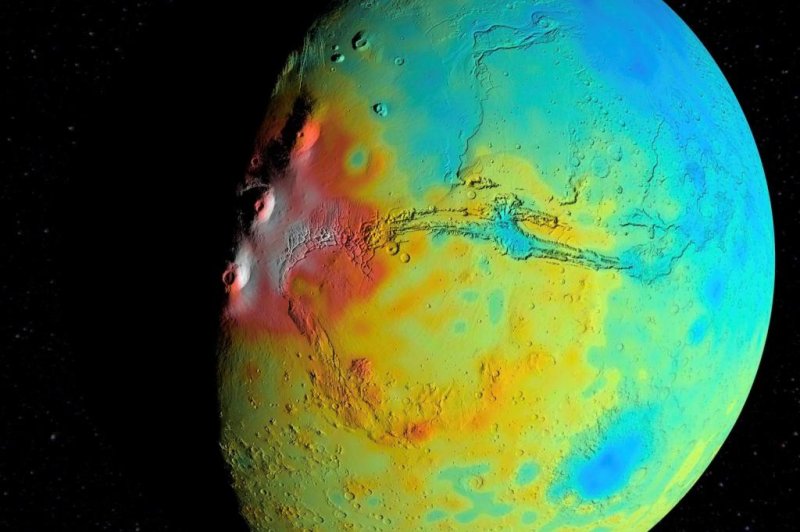Researchs used newly calibrated gravity field data to map the density of Mars' crust. Photo by NASA/Goddard/UMBC/MIT/E. Mazarico
Sept. 14 (UPI) -- New analysis of Martian gravity data suggests the Red Planet's crust is not as dense as previously thought. In fact, much of Mars' crust is likely porous.
"The crust is the end-result of everything that happened during a planet's history, so a lower density could have important implications about Mars' formation and evolution," Sander Goossens, a researcher at NASA's Goddard Space Flight Center, said in a news release.
Until now, scientists believed the density of Mars' crust was compatible to that of Earth's oceanic crust, roughly 181 pounds per cubic foot. The latest research -- detailed in the journal Geophysical Research Letters -- suggests Mars' crust is more like the moon's crust, with a density of about 161 pounds per cubic foot.
High-resolution surveys of Earth's gravity field captured by NASA's Gravity Recovery and Interior Laboratory, or GRAIL, in combination with complex mathematical models, have allowed scientists to precisely map the density of Earth's crust. GRAIL data also helps scientists map the moon's crustal density.
But surveys of Mars' gravity field are lacking in resolution.
To squeeze as much as they can from the gravity field data, researchers have to apply one or more constraints. Scientists have previously used the composition of Mars' soil and rocks as a constraint on the Red Planet's gravity data. But scientists have expressed doubts about the accuracy of such a method.
"As this story comes together, we're coming to the conclusion that it's not enough just to know the composition of the rocks," said Greg Neumann, a planetary geologist at Goddard. "We also need to know how the rocks have been reworked over time."
In the newest analysis of Martian gravity data, researchers used a different constraint -- a topographical map of the Red Planet. Using elevation changes as a constraint on the gravity dataset allowed scientists to more accurately estimate the density of Mars' crust.
"With this approach, we were able to squeeze out more information about the gravity field from the existing data sets," said Goddard geophysicist Terence Sabaka.
To confirm the accuracy of their new statistical analysis technique, researchers applied the method to older lunar gravity field data sets and compared the results of the surveys powered by GRAIL data. Both models produced similar results.















